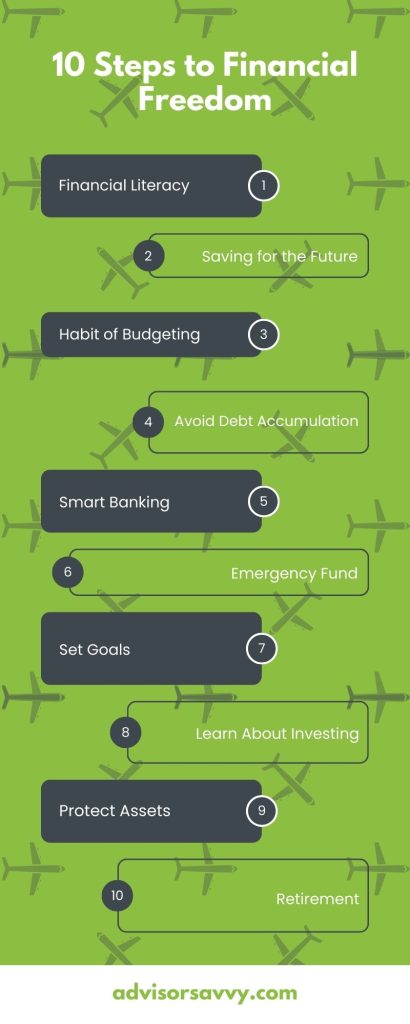
Financial freedom is one of the most talked-about topics. We all joke about winning the lottery tomorrow and what we would do with all that money. What most people certainly wouldn’t do is go to work! Sadly, many have yet to experience true financial freedom. But maybe if they knew the 10 steps to financial freedom, we would all be living our dream life.
If you’ve always dreamt of a kind of life where you don’t have to worry about money or go to work to pay the bills, it’s absolutely possible. Financial freedom is beyond a nice theory. Anyone can achieve it by taking the right steps. In fact, part of achieving it is learning the correct definition of financial freedom, which we will also explore in this article.

Table of contents
Do you want to become financially independent? We’ve shared the 10 steps to financial freedom in this article. Continue reading to learn more!
What is financial freedom?
Before we explore the 10 steps to financial freedom, let’s define what financial freedom means exactly. Financial freedom can mean different things to different people so it is a bit tricky. But generally speaking, it’s the state of not having to rely on anyone else to meet your financial needs. In other words, financial freedom means having enough cash, savings, and investments to live how you want. A financially free individual has control of their finances, enabling them to live on their terms.
What financial freedom isn’t is a certain dollar amount in the bank or an excessively large investment portfolio. Sometimes we can think of financial freedom as this larger than life thing — like $10 million dollars in cash. That’s not exactly how it works. Rather, it’s about being able to sustain your lifestyle without having to rely on anyone else.

What are the 10 Steps to Financial Freedom?
Anyone can be financially free by heeding the right financial principles and practices. Yes, it requires a plan and the discipline to stick to it. We said anyone could do it, not that it would be particularly easy! Let’s consider the 10 steps to financial freedom below.

Match to your perfect advisor now.
Getting started is easy, fast and free.
1. Financial Literacy
Before you can manipulate the rules, you must learn them. Begin by understanding core financial concepts and increasing your financial literacy. These include budgeting, debt management, compounding, saving, and investing. Why does this matter? This knowledge equips you to manage your finances effectively. Adequate financial management is at the heart of financial freedom.
If you lack this vital knowledge, you can be earning huge dollar amounts but racking up debts. Of course, this will eventually leads to a dead end. Some say it’s easy to make a million dollars but infinitely difficult to keep it. This is why financial literacy matters!
In addition to molding your money habits, financial literacy also shapes your perception of money. For example, one of the basic financial principles says to look at money positively. If you’re one of those people that believes becoming wealthy is difficult, this mindset can affect your money habits unconsciously. Learning about finances debunks such ideologies while empowering you with financial skills.
Thankfully, there are a lot of resources out there to help you improve your financial literacy skills. This ranges from financial books, courses, podcasts, films, and even social media. You could also consult a financial advisor or other similar specialist.

Match to your perfect advisor now.
Getting started is easy, fast and free.
2. Saving for the Future
You don’t necessarily need to be a high earner to achieve financial independence. If you’re committed to cutting costs and saving, an average salary is a great start. To begin with, your savings provides a financial backup in the case of unexpected events. It can also be your seed capital for investments or starting a business. And what if you were to lose your job? Here again, your savings can serve as an emergency fund. So, you see, having savings is a no-brainer.
Starting saving on little stuff like coupons, electricity, entertainment, and other regular expenses. Channel the little cut-offs to your savings account. As you get into the swing of saving, it’ll be easier to save larger and larger chunks. Also, as your savings grow, so will your motivation to keep going.
Another recommended approach to saving is “pay yourself first.” This means your savings comes before anything else, including bills. Why is that? If you choose to allocate money to every other expense first, you’ll end up saving only what’s left-over. If you go that route, you may have little money to put into your savings.
These days, automated transactions has made saving easier. You just need to connect your card to your savings account and set your recurring savings allocation for a specific date. Some people ask, what’s the right amount to save? Frankly, there’s no hard and fast rule when it comes to this, but 20% of your earnings is a good benchmark.
3. Habit of Budgeting
It’s one thing to desire to be financially independent and another to have a concrete plan to reach your goal. In this life, everything is easier said than done!
Budgeting is simply having a spending plan to keep track of your income and expenditures. With budgeting, you can track how much you make, how much you spend, and what you spend on. Don’t forget to allocate some of your income to saving. You may find that all your money goes out as soon as it comes. You don’t want that right? Then, draw up a budget today and stick to it!
4. Avoid Debt Accumulation
We understand that sometimes borrowing may be the only option to get yourself out of a financial mess. However, don’t normalize borrowing or rely on it to cover daily expenses. Especially for high-interest loans and credit cards, if you’re unable to pay at the agreed time, the interest keeps growing. It may get to a point where the numbers become overwhelming. If you do have debt, create a plan to pay off your debt. Allocate a specific amount of your monthly income to debt repayment using your budget.
Related Reading: CPP vs OAS: What are the differences?
5. Smart Banking
As technology continues to improve, various processes are becoming easier, including banking. Banks are leveraging technologies to provide swift and seamless banking services to customers. The way we carry out transactions, and make purchases and payments are now quicker — many thanks to online channels and platforms. This also means that achieving financial freedom is a lot easier.
For example, now you can automate your savings. At a specific date, your bank automatically transfers a certain amount of money into your savings account. This provides a way for you to stay committed to your financial goals. You could also automate your payments for bills to avoid late payments and consequent fees.

Match to your perfect advisor now.
Getting started is easy, fast and free.
6. Emergency Fund
An emergency fund is a must if you want to be financially free. It is a lump sum of cash set aside for unexpected expenses. No matter who you are, you must expect that life will happen which comes at a price. In times of critical financial pressure, you wouldn’t have to resort to high-interest loans or credit cards. In the case of job loss, you can sustain yourself from the fund while you seek a new job.
How much should you have in an emergency fund? The right amount to set aside for emergencies depends on your lifestyle. However, the general advice is to have enough in your fund to cover at least three months’ worth of living expenses.
7. Set Goals
What are financial goals? Financial goals are monetary milestones you wish to achieve within a given time frame. It could be to retire early, pay off a loan, further your education, or buy property. Setting goals keeps you conscious of the big picture so you can work towards it.
Here’s a quick tip to help you come up with a goal. Ask yourself what do I want out of life? Where do I want to be in the next 3, 5, or 10 years? Answering this question will help you arrive at both short and long-term financial goals — both of which are important.
8. Learn about Investing
Investing is making your money work for you. If you’re tired of the financial rat race, it’s time to consider this smart wealth creation approach. There are lots of investments to take advantage of. While some are less risky, others carry a significant amount of risk.
The first step is learning to differentiate the types of investments and their inherent risks. Stock investing, for example, is among the most popular types of investment. However, stocks are very volatile and may not be a good pick for beginners. Yet, the best investor of all time, Warren Buffet, made his fortune from it. Real estate and commodities are more stable investments, but you have to work with a long-term investment horizon. The point is, learning about investing is important. Without it, it will be challenging to achieve financial freedom.
Related Reading: How to Invest $1,000, $10,000 or $100,000
9. Protect Assets
When you have successfully invested your money, you now have something to protect. You can protect your assets and wealth through insurance. If something were to happen to your assets, you can recover the loss through an insurance claim.
However, the day to day preservation matters too. For instance, you should ensure your real estate is properly maintained, otherwise you might run into an expensive home repair. If you have a car, make sure you don’t skip oil changes and annual tune ups, or else you might be stuck buying a completely new car.
10. Retirement
The last of the 10 steps to financial freedom is planning for retirement. After all, no one wants to work forever. Some people plan to retire as early as 45. But in order to pull this off, you have to get serious about saving and investing early on.
What is the fastest way to financial freedom?
Reaching financial freedom takes a lot of commitment and effort. It is by no means easy, otherwise everyone would be financially free! In addition, there isn’t really a “get rich quick scheme” because, again, everyone would do it. The reality is the only way to financial freedom is to go through the process.
With that said, there is a tried and true method which is the culmination of the 10 steps to financial freedom listed above. Yes, it’s not glamourous or exciting, but what we do know is it works!
How can I be financially free?
Financial freedom is a mindset before it is anything else. If you’re struggling to reach your financial goals and become financially free, consider working on your attitudes and behaviors in relation to money. You can also consider working alongside a professional to help you determine areas for improvement. Fill out this questionnaire today to be matched with a financial advisor!
Read More: Personal Financial Planning for Every Generation

